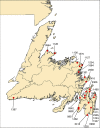A Newfoundland cohort of familial and sporadic idiopathic pulmonary fibrosis patients: clinical and genetic features
- PMID: 22853774
- PMCID: PMC3463483
- DOI: 10.1186/1465-9921-13-64
A Newfoundland cohort of familial and sporadic idiopathic pulmonary fibrosis patients: clinical and genetic features
Abstract
Background: Idiopathic pulmonary fibrosis (IPF) is an adult-onset Idiopathic Interstitial Pneumonia (IIP) usually diagnosed between age 50 to 70 years. Individuals with Familial Pulmonary Fibrosis (FPF) have at least one affected first or second-degree relative and account for 0.5-20% of cases.
Methods: We ascertained and collected DNA samples from a large population-based cohort of IPF patients from Newfoundland, Canada. For each proband, a family history was documented and medical records were reviewed. Each proband was classified as familial (28 patients) or sporadic (50 patients) and all 78 probands were screened for variants in four highly penetrant, adult-onset PF genes (SFTPC, SFTPA2, TERT,TERC).
Results: Seventy-eight IPF probands were enrolled of whom 28 (35.9%) had a positive family history. These 28 familial patients led to the recruitment of an additional 49 affected relatives (total of 77 FPF patients). By age 60 years, 42% of the familial cohort had been diagnosed with PF compared with only 16% of the sporadic patient collection (χ2 = 8.77, p = 0.003). Mean age of diagnosis in the familial group was significantly younger than the sporadic group (61.4 years vs. 66.6 yrs, p = 0.012) with a wider age range of diagnosis (19-92 years compared with 47-82 years). Thirty-three of 77 (42.8%) FPF patients had a tissue diagnosis and all but five had usual interstitial pneumonia histology. Compared with other published case series, the familial IIP histologies were more homogeneous. Three of 28 familial probands (10.7%) and none of the 50 sporadic probands had pathogenic variants in the four genes tested. All three familial probands had mutations in TERT. Other phenotypes associated with telomerase deficiency were present in these families including cirrhosis, bone marrow hypoplasia and premature graying. Telomere length assays were performed on mutation carriers from two families and confirmed telomere-related deficiency.
Conclusion: The proportion of familial cases in our cohort is higher than any previously reported estimate and we suggest that this is due to the fact that Newfoundland cohort is ethnically homogeneous and drawn from a founder population. In our patient collection, diagnosis with IPF prior to age 45 years predicted familial disease. In two of the three TERT mutation families, the pedigree appearance is consistent with genetic anticipation. In the other 25 FPF families negative for mutations in known PF genes, we did not identify other telomerase associated medical problems (bone marrow dysfunction, cirrhosis) and we hypothesize that there are novel PF genes segregating in our population.
Figures


References
-
- King TE Jr. Interferon gamma-1b for the treatment of idiopathic pulmonary fibrosis. N Engl J Med. 2000;342(13):974–975. - PubMed
-
- American Thoracic Society/European Respiratory Society International Multidisciplinary Consensus Classification of the Idiopathic Interstitial Pneumonias. This joint statement of the American Thoracic Society (ATS), and the European Respiratory Society (ERS) was adopted by the ATS board of directors, June 2001 and by the ERS Executive Committee, June 2001. Am J Respir Crit Care Med. 2002;165(2):277–304. - PubMed
Publication types
MeSH terms
Substances
LinkOut - more resources
Full Text Sources

